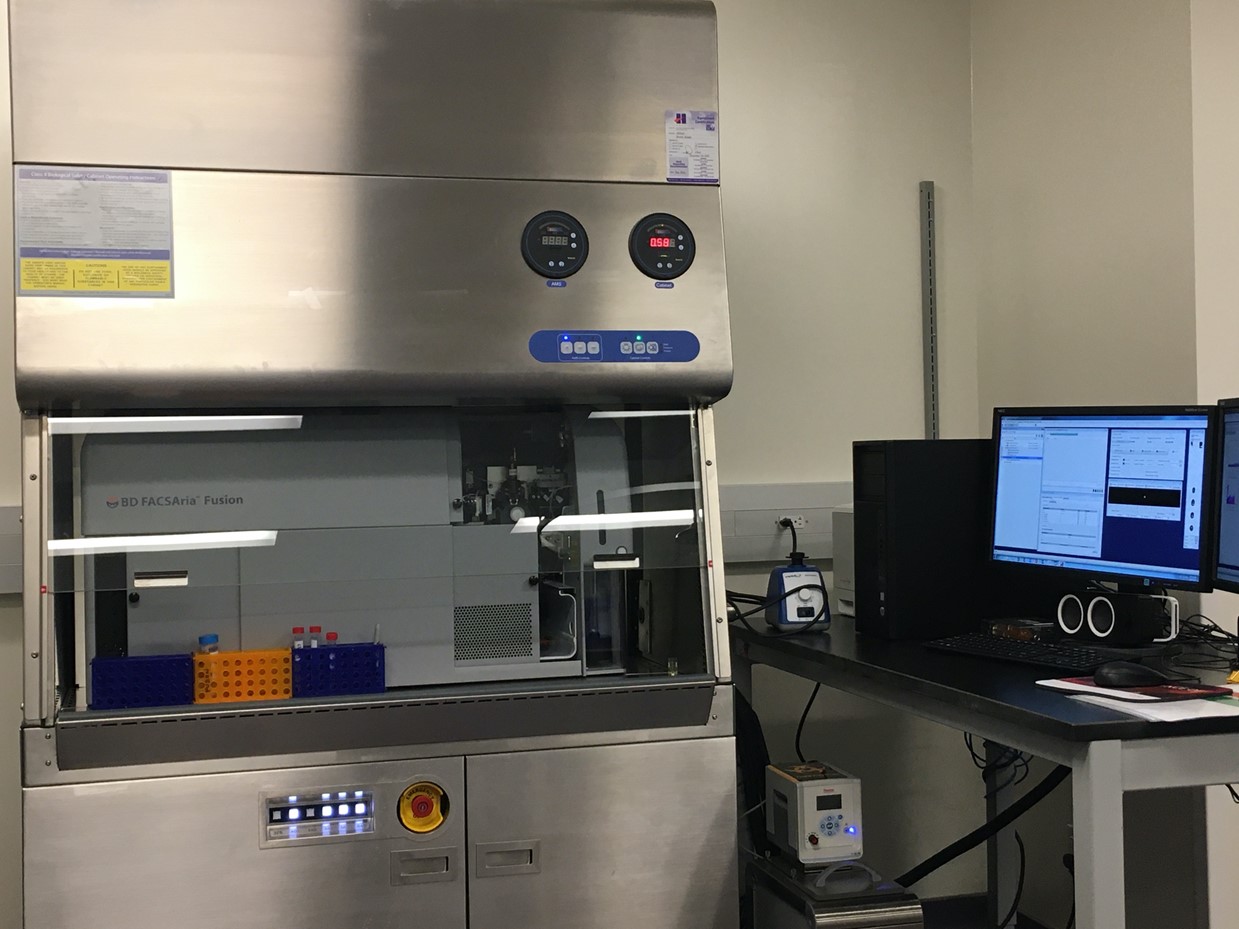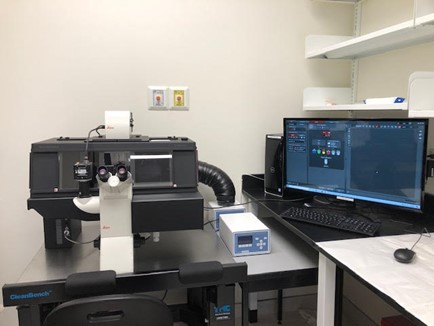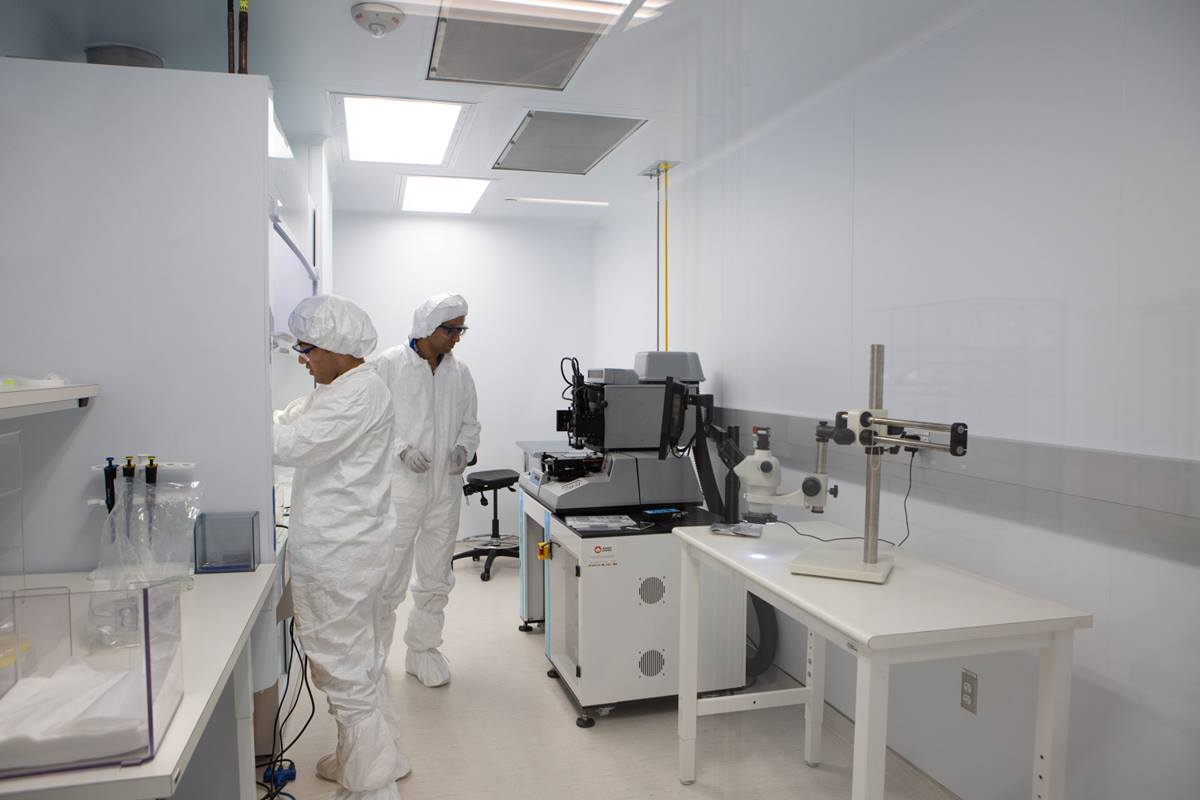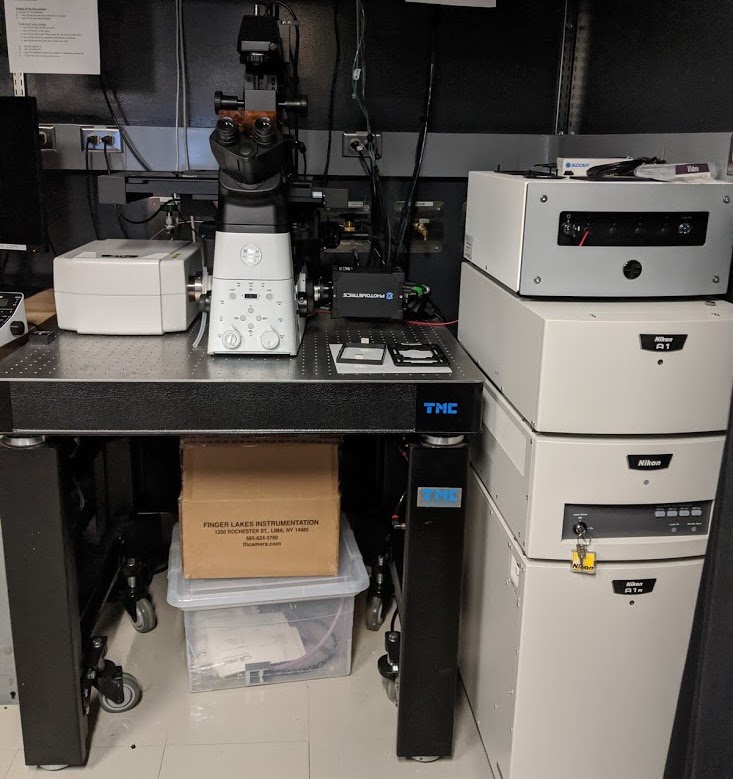Equipment
Toronto—University of Toronto (Ted Rogers Centre)

The BD FACSAria Fusion is a high-speed sorter with a fixed-alignment, gel-coupled cuvette flow cell housed in a biosafety cabinet. This flexible cytometer provides superior performance in high-speed cell sorting and multicolor analysis, as well as index sorting. The lasers and nozzle, through which cells pass, are automatically aligned; their fixed positions ensure that results are reproducible. There are three nozzle sizes, designed to fit small, medium and large cells. The 4 laser, 16 color configuration allows users to easily sort up to four types of highly purified, sterile cell populations at a time. Our interest lies in accurately sorting immune cells such as macrophages and rare dendritic cells, and non-immune cells such as fibroblasts and endothelial cells. The index sorting feature allows us to review the complete cell surface phenotype of every cell sorted into a 96-well plate. These purified cell populations are crucial to building, and expanding, the Organ-on-a-Chip technology.
Toronto—University of Toronto (CRAFT)

This tool will enable the printing photo-crosslinkable resin at a high resolution down to the sub-micrometer level, which is higher than the resolution achievable with conventional photolithography techniques. This opens the door to exploring the possibility of directly printing biomaterials with features that are small enough to provide structural and topographical guidance on a single-cell level, which is crucial to organ-on-a-chip applications. Previous studies have found that the ability to create small, high-resolution features, such as micro-holes for cell extravasation, contributed greatly to the success of scaffold-based micro-tissue models.

This instrument will be the first of its kind in Canada and will be able to rapidly produce glass components from fused silica with micrometer scale resolution using selective laser-induced etching (SLE). It will oqCORE users to completely eliminate drug absorbing PDMS from organ-on-a-chip devices. Users will be able to rapidly print glass microfluidic devices with enclosed conduits.

To be added

The first of its kind in Canada the FOM moduloR²C roll-to-roll polymer coater features a flexographic printing station along with a slot-die coating station for the large-scale fabrication of low-cost microfluidic and organ-on-a-chip devices. This will help oqCORE users to translate products from research laboratories to the market via start-up companies and licensing.

Prototyping of organ-on-a-chip devices can be done with soft lithography or hot embossing for initial tests and analyses. These methods produce a handful of devices in one cycle, which can take several hours to a day. Once refined designs are chosen, fabrication needs to be performed in a high throughput machine such as an injection moulder that can manufacture hundreds of organ-on-a-chip reactors on demand. The injection moulder produces devices at high frequency (1 device/10 seconds) and allows a continual supply of devices that can be used for testing. Injection molding technology is out of reach for many investigators due to the high cost and slow lead time from companies. Having a state-of-the-art injection molding machine will enable the entire research community of our Center to use this powerful technique. The injection moulder will enable researchers to mass produce optimized designs in a cost- and time-efficient way.

The multiplexed organ-on-a-chip platforms currently being developed by oqCORE users do not require syringe pumps and instead employ standard wells as inputs and outputs and have integrated flow control. A commercial fluid handling station will allow for fully automated loading of multiple cell types and biomaterials, for the exchange of culture media, for adding well-defined amounts of drugs, as well as for routinely absolving staining protocols. An automated liquid handler can be used with well plates, and devices matching the well plate format, for all liquid handling needs. The automated liquid handler will be able to perform actions such as reagent delivery, mixing, heating/cooling, centrifugation, cell incubation, plate reading, and more. Automated liquid handling will allow us to test devices commensurate to the standards of the pharmaceutical industry.

Light-Sheet Microscopy System
This powerful system will allow for mapping of cell migration on-line in 3D samples and for studies of dynamic processes at a cellular level. It will also enable continuous imaging of living organisms for extended periods of time without inducing damage to the organism or photobleaching. Users will be able to monitor living organ-on-chip cultures for prolonged time periods (e.g. hours) to study cell extravasation and molecular transport.

Slide Scanner
This instrument will be capable of automatically scanning an entire slide with a stained tissue section to complement the analysis of non-destructive imaging enabled by Light-sheet microscopy. It will be used for analysis of tissues produced by our new platforms, to confirm that the tissue structure indeed resembles that of the native organ. This instrument will allow scanning of numerous slides at once, without losing resolution, enabling quick digital zoom-ins, so that the subsequent analysis can be performed at an off-site computer at the office or at home.
Toronto—Ryerson University (St. Michael’s Hospital)

This inverted microscope, Phantom M110 high speed camera, and incubator combination is for microfluidics experiments that feature a combination of live cells (i.e. organs-on-chips) and micro and nanobubbles, for in vitro tests of bubble-based ultrasound contrast agents for imaging and therapeutic applications. The flow visualization experiments in organ-on-a-chip devices that involve the flow of micro and nanoparticles will have dynamics that occur at millisecond-timescales, which means that this visualization equipment is able to capture images at a rate of 1000 frames per second.

The microfabrication equipment is specifically configured to produce items that will be in contact with patient samples, with the flow of people and material being precisely controlled. The equipment is located in a class 10,000 (ISO class 7) cleanroom space that is adjacent to BSL-2 labs, making patient sample transfer safe. Available equipment includes a NxQ 4006 mask aligner, a Bruker Contour GT-K optical profilometer, Laurell WS-650 spin coaters, and Torrey Pines HS40 hot plates.
Montreal—McGill University

As part of the Ontario-Quebec Centre for Organ-on-a-Chip Engineering, an advanced microscopy facility has been installed in Dr. Juncker’s laboratory at McGill University since late 2019. The Nikon Ti2/A1R+ resonant scanning inverted confocal microscope is equipped with a resonant laser-scanning confocal module and live cell chamber, enabling epifluorescence and simultaneous confocal/DIC imaging. It provides a i) rapid, resonant scanning confocal head, ii) piezoelectric stage, and iii) a large 22 nm field of view in widefield/ 18 mm field of view in confocal, allowing for the fastest possible acquisition time in high-content experiments, which is essential for monitoring the physiology and response of cells within 3D organs-on-chip. This is currently being used to investigate the biochemical factors involved in the vascularization of brain organoids in a high-throughput organ-on-chip platform. The microscopy platform is also utilized for i) analyzing the biomarker expression of circulating tumour cells (CTCs) from patient samples, ii) multiplexed exosome capture based on surface markers, and iii) co-culture arrays to investigate interactions in the tumour microenvironment, all to establish physiological concordance to larger organs.

Coming soon
Hamilton—McMaster University

Coming soon

Coming soon
Toronto—University Health Network

Organ-on-a-chip devices being developed by our users will be multiplexed into bioreactors with a footprint of a 96-well plate. Our instrument will be able to read responses in drugs screens in a high- throughput manner, making this instrument is absolutely critical for our ability to operate in an industrially relevant manner. High-quality images will be captured rapidly from dim biological samples, while modules for environmental control, liquid handling, temperature control, transmitted light imaging, and slide handling significantly extend the range of assays that can be performed.
